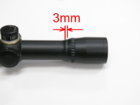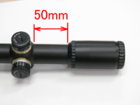Loose ocular/eyepiece lens causes a point of aim shift?It causes a large poa shift,
I disagree. Unless there is a parallax issue caused by a target range focus error.
With the objective lens group's target image focused in the reticle plane and aim point centered on the reticle center, the point of aim stays there regardless of the aiming eye viewing angle or crooked eyepiece. That's when there's zero parallax, anyway you look at it.
Loose objective lenses in something that will cause a POA and LOS shift.
Last edited:













